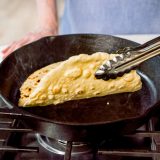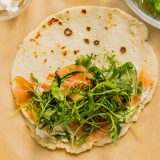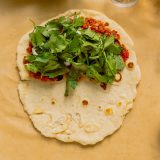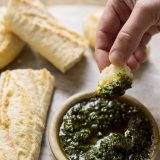There is bread and there is, well, quick bread. They serve different needs and are rolled out at different times.
Among the quickest of quick breads is flatbread, the weeknight allure of which is widespread. Consider pitas, nan, chapatis, tortillas, man’oushé.
Whether leavened or not, folded, topped or used as a scoop, flatbread promises warm, fresh bread—fast. It is simple to make and, from Southeast Asia to North America, the crisp or chewy crusts easily take to fillings and toppings both sweet and savory.
One of our favorite variations originated in Romagna, in northern Italy. There, they throw together flour, salt, water or milk, and lard or olive oil to make a quick dough. After a short rest, the flatbread—a piadina—is cooked on a griddle or skillet. (Piadine originally were cooked over coal fires using a large clay pan called a teglia di Montetiffi.)
The cooked piadine are then stuffed with fillings (Parma ham, soft cow’s milk cheese and arugula are a classic combination) and folded in half to make a sandwich—similar to the way New Yorkers enjoy slices of pizza.
We found two main variations in traditional recipes. For thin, crispy breads, flour, salt and water are sufficient. For a softer, lighter texture, bread dough needs fat (butter or eggs, for example) and leavening. We preferred the latter style, so we started by looking for the right fat.
Butter was wrong; the flavor was out of place and it produced an unwelcome flakiness. Egg made the dough too dense, sticky and hard to work with. Olive oil gave us pleasant texture and flavor, but something was still missing.
Until then, we’d resisted lard; few home cooks still use it. But it remains widely available, so we made a batch with it. And what a difference. The piadine were tender with just the right chew and a deeper, richer background flavor. We also tested vegetable shortening, which gave us the same supple dough but lacked a bit of flavor. Lard was the clear winner.
For the dry ingredients, bread flour was better than all-purpose for handling reasons. Baking powder produced pizza crust-style bubbles.
Even with lard and bread flour, we wanted to make the dough as supple as possible. We found our answer in nan, one of India’s tender flatbreads that often calls for a scoop of yogurt in the dough. Though it seemed heretical in an Italian bread, we knew the fat in yogurt would hinder gluten development, keeping the dough soft. It worked well in our piadine, with an unexpected bonus: It gave the bread more complex flavor.
Mixed in a food processor, the dough came together in minutes. But there were times when we encountered problems with it gumming up around the blade. To troubleshoot, we reduced the initial amount of water mixed with yogurt. Then we added water to the dough 1 tablespoon at a time as it mixed.
Once it was balled up and smooth, we divided the dough and rolled it into thin rounds. We fiddled with what temperature was best for heating the cast-iron skillet. In the end, medium heat provided the most even cooking. Bubbles formed on top of the dough as it cooked, but the telltale sign for flipping each round was the development of flavorful charred spots on the bottom.
The hot rounds worked well with any number of simple toppings. We favored simple combinations with just a few ingredients. If cheese is in the mix and you’d prefer it melted, just slide the topped piadina under the broiler.
To eat, fold the piadina, as they do in Romagna, or leave it flat. Or use it to swipe up spicy herb oil, hummus or baba ghanoush. It’s homemade, freshly cooked flatbread—tastier than carry-out, faster than delivery.







